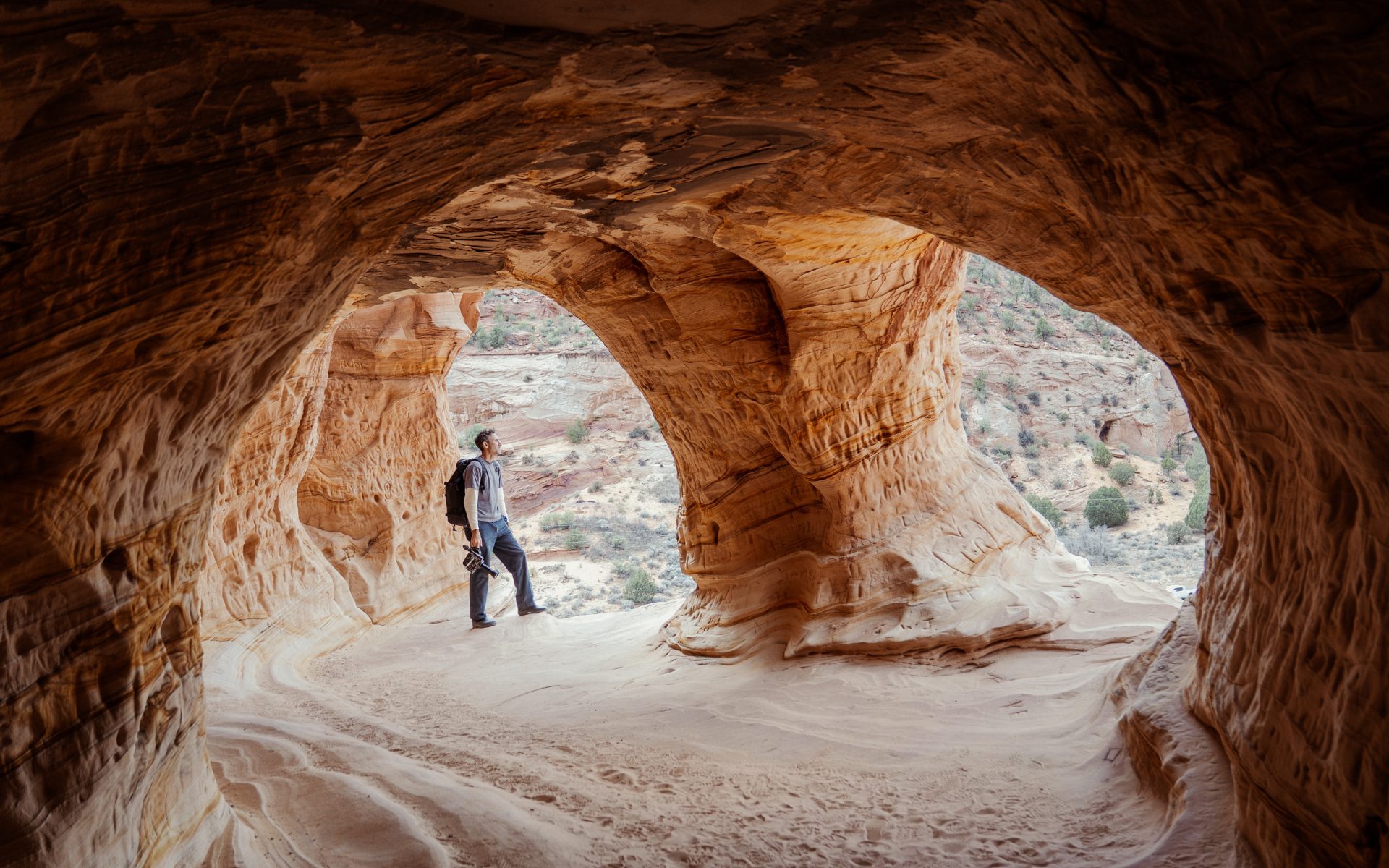On an all-electric road trip across Utah, Adventure.com managing editor Tayla Gentle goes searching for hyper-local community travel experiences and finds herself learning how to snowshoe, decipher a petroglyph panel and cook a quiche from scratch.
I’ve done many things in my life, but this is the first time I’ve walked through a portal leading to the spiritual center of the earth.
The towering portal is incongruent with the sprawling desert prairie all around; the flat, flat earth stamped with sage brush and dancing with hazy heat. It juts from the ground, a 600-foot (183-meter) sandstone monolith interrupting the otherwise tedious horizon, and straight down its center, an ancient path bisects the rock.
Over the course of millennia, water and wind have slowly etched the path, known as the Parowan Gap, creating a slot now wide enough for a two-lane road. For most travelers, the Gap is a relatively obscure pit stop on the drive through south-central Utah. But for the Indigenous Hopi tribe, the gap is sacred—once used by their ancestors as they migrated to Tuuwanasavi (earth center).
This is Smoot’s second career. Before becoming a mountain guide, he was an oil and gas man; a professional about-face that makes me like him even more. “Now, my goal in life is to teach the younger generation about the beauty that’s out here,” he says. “And the importance of not being just takers, but to find ways to give back.” He does this by leading youth groups out into the wilderness on excursions just like this.
I’ll admit, seeing this part of Utah on snowshoes—once I’ve found my stride—is certainly calming. The air out here is scented with crisp conifer; my eyes track the winding Bear River as it flows all the way to the Great Salt Lake. I can see why Smoot loves this land, and I’m glad this land has such a passionate advocate in a gas-man-turned-guide like Smoot.
Do: Eat at Angie’s, a locally owned and locally loved diner.
Donate: The Nature Conservancy, who are striving to protect areas like Bear River.
Despite having seen The Book of Mormon musical three times, my knowledge of Salt Lake City is, admittedly, lacking. Skewed, even. I didn’t know Mark Twain once met Brigham Young, the second president of the Church of Jesus Christ of Latter-day Saints; and I had no clue about the city’s thriving, super-local food scene.
“Oh yeah, our food scene is very underattended,” chef Ray Mucillo says, offering me a hunk of cheddar cheese, made “cow-to-cave”—as Mucillo calls it—at a nearby farm and flavored with butter and duck fat. “We’re trying here to make food that’s high quality, that helps support the farms and that’s also good for the environment.” Because, as it turns out, Utah has a lot of farms. More than 18,000 of them.
But where did this foodie scene come from? Mucillo attributes some of it to the influence of Mormonism, with its foundational beliefs rooted in self-sustainability, self-sufficiency and working as a community. But the agricultural industry in the state is also thriving, so a connection to the food source is closer to home here, literally. “I think that’s encouraged a lot of Utahns to develop an interest in foodie culture… We have restaurants here that deserve Michelin stars.”
Table X is one of those restaurants. With a kitchen garden out the back, and a parking lot lined with fruit trees, its seven-course tasting menu is a farm-to-table feat. And feast. From the lamb shoulder topped with stinging nettle cream to the delicate trout poached in a brown butter nage (French broth), I can’t choose a favorite. But I do know Salt Lake City has just become one of my favorite food scenes.
Do: Pick up a local charcuterie board and head out to Antelope Island State Park.
Donate: New Roots help refugees in Salt Lake City feed themselves through small-scale urban farms and community gardens.
Today, I’m searching for a petroglyph panel that dates back over a thousand years. It’s baking as we hike one of the many canyon beds, kicking up sand as we scour the area for markings. I stop in the shade of a sandstone cliff, a vulture circling overhead, and try to imagine the Hitsatsinom here, walking in their moccasins down this very trail.
Despite our vigilance, there are no signs of petroglyphs, so as the sun tracks higher, we decide to turn around. And it’s only then that we spot the bighorn sheep carved into a wall about 10 feet (three meters) off the ground. Beside that, we spy the anthropomorphic figures, followed by the spiraling symbols. We had missed the entire panel.


